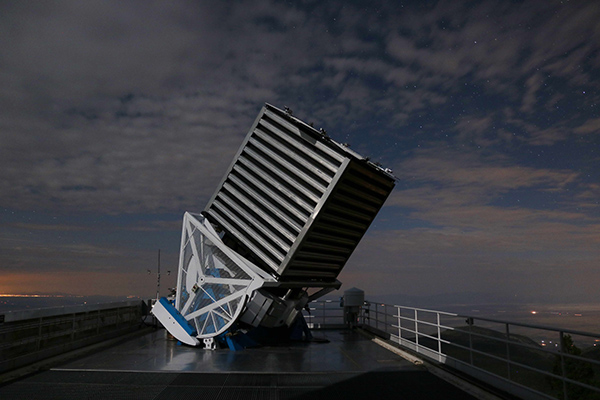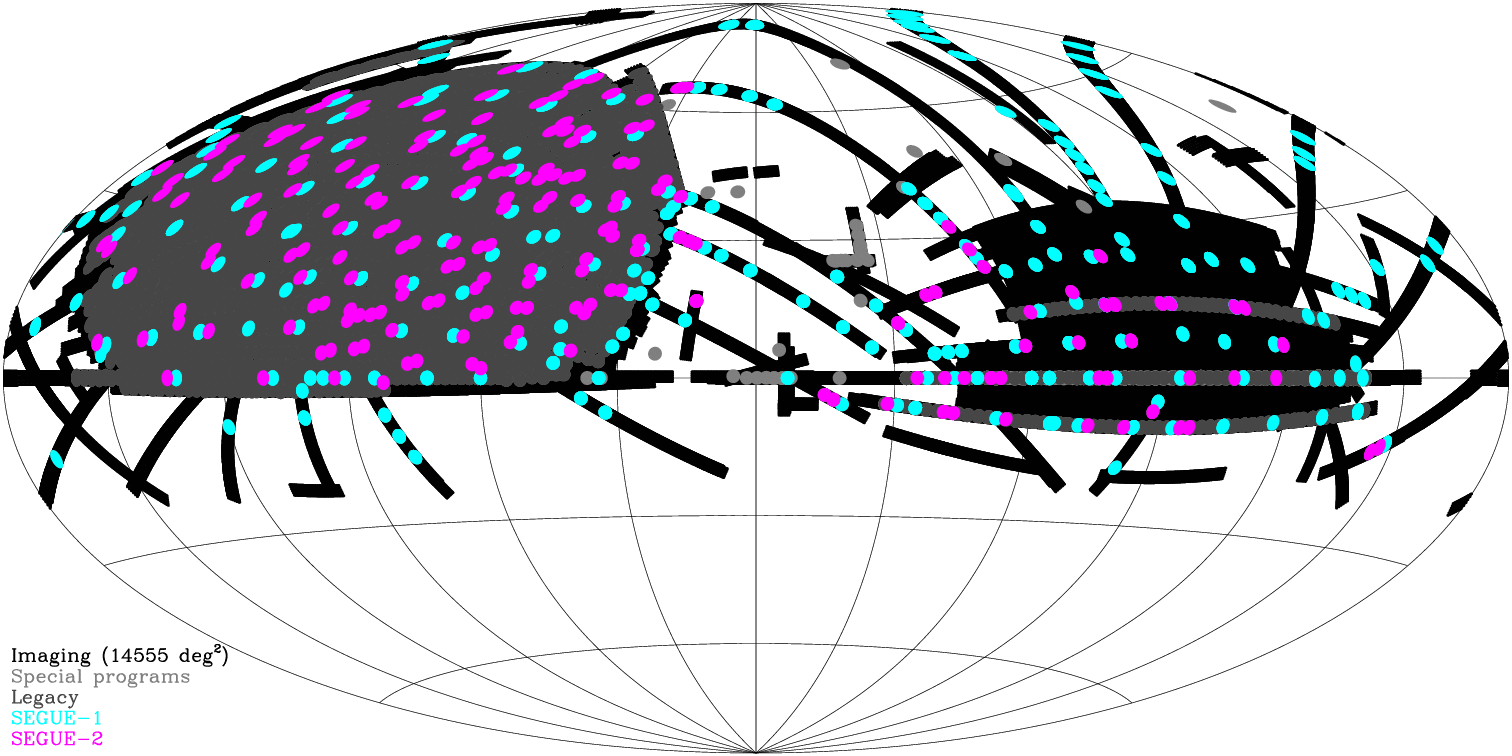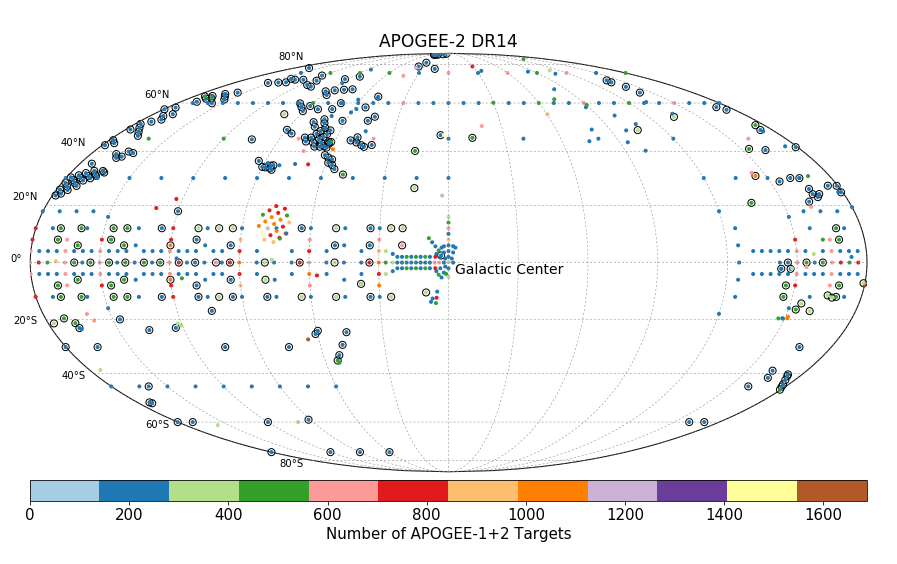DR14 Highlights
Data Release 14 (DR14) is the second data release of the fourth phase of the Sloan Digital Sky Survey (SDSS-IV). DR14 contains SDSS observations through July 2016.
DR14 includes the following:
- The first optical spectra of galaxies and quasars from the SDSS component extended Baryon Oscillation Spectroscopic Survey (eBOSS), including spectra from the eBOSS subprograms SPectroscopic IDentfication of ERosita Sources (SPIDERS) survey and Time-Domain Spectroscopic Survey (TDSS)
- The first stellar infrared spectra and stellar parameter determinations from the SDSS component Apache Point Observatory Galaxy Evolution Experiment 2 (APOGEE-2)
- More data cubes from integral field unit (IFU) spectroscopic observations of nearby galaxies from the SDSS component Mapping Nearby Galaxies at APO (MaNGA)
- Value Added Catalogs (VACs) for all three SDSS components (eBOSS, APOGEE-2 and MaNGA), including targetting catalogs
- The most current reprocessed imaging and spectra from the SDSS legacy survey
DR14 directly follows DR13. As always, SDSS data releases are cumulative, so DR14 includes all the sky coverage of prior releases. Data Release 12 and Data Release 13 are still available on this website, and prior data releases are available from www.sdss3.org (for DR8 through DR10) or classic.sdss.org (for DR1 through DR7).
Working with SDSS Data
If you use public SDSS data in your paper, please see our guide on how to cite the SDSS. We hope you find our resources useful!
If you have questions about working with SDSS data, please email our helpdesk.
Accessing the Data
The SDSS offers several different online data access tools, each suited to a particular need:
- Website
- Purpose
- DR14 Science Archive Server
- Interactive spectra and image mosaics
- DR14 SkyServer
- Browser-based access to the Catalog Archive Server (CAS) database, with resources for learning SQL and projects to teach science
- CasJobs
- Flexible advanced SQL-based interface to the CAS, for all data releases (quick registration required). To select data from DR14, choose DR14 as the query context.
- DR14 FITS
- Direct download access to DR14 FITS data files for experts
- Data Model
- Details of the Science Archive Server (SAS) directory structure, file formats, and the contents of each file
About Data Release 14
The links below give more information about various aspects of DR14. The links are also available from the second-level menubar at the top of each page in the DR14 section of this site.
- What's new?
- Explains the differences between DR14 and previous data releases.
- Scope
- Describes what data are available in DR14, including sky coverage, data size, and resolution information.
- Datasets
- Shows how to get common types of SDSS data, and provides links to all SDSS data access tools. This is the best place to look for a quick start using SDSS data.
- Imaging
- Explains what imaging data DR14 contains. It also provides details on the SDSS imaging pipeline, the calibration process, and what quantities (including units) are available in imaging catalog data.
- Optical Spectra
- Explains what data are available from the SDSS's two optical spectrographs (SDSS-I and BOSS), and provides details on associated data, including target flags, redshifts, and classifications.
- APOGEE Spectra
- Explains what data are available from the SDSS's APOGEE infrared spectrograph, and provides details on associated data including information on the spectra, targets, radial velocities, and determinations of stellar atmospheric parameters.
- MaNGA Spectra
- Describes the available data and methods from the new component survey Mapping Nearby Galaxies at APO (MaNGA), which uses integral-field spectroscopy to learn about the dynamics and compositions of nearby galaxies.
- MARVELS Spectra
- Describes the data and methods of the MARVELS component survey, which searched for extrasolar planets around nearby stars.
- Algorithms
- Lists the principal SDSS data processing algorithms, including target selection, and contains complete details on how the algorithms work. It also includes software for working with SDSS data.
- Help
- Contains a glossary, Frequently Asked Questions, and other resources to help you get started in using DR14.
- Tutorials
- Provide step-by-step guides to common research and teaching tasks using SDSS data. This is a good place to look for guidance in doing your science with the SDSS.
Complete details about DR14 are documented on this site, and in the preprint of the Data Release 14 paper (Abolfathi et al. submitted, arXiv:1707.09322).








